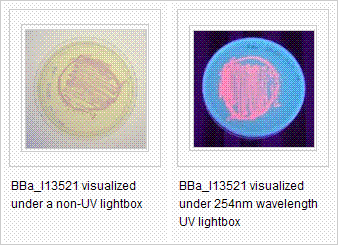What other cool reporters are there? (Discrete On/Off or Continuous) Bryce Szczepanik
Contents
What is a reporter?
A reporter is a gene that can be attached to another gene of interest in DNA. Certain genes are chosen as reporters because the characteristics that they confer on the organism that is expressing them are easy to measure and see. Reporter genes are usually used as a marker to determine if a given gene has been expressed in an organism.
Examples of reporters
Color
With all of the different color outputs available (a few are shown below) each different gene could be coded for by a different color.
Part: BBa_I13521 is RFP or red fluorescent protein. When visualized under UV light, a luminescent red color can be observed in organisms exhibiting the gene.
Part: BBa_E0240 is GFP or green fluorescent protein.
Part : BBa_I13600 is CFP or cyan fluorescent protein. In the absence of the tetR protein, CFP expression is constitutive. tetR represses CFP production; this repression can be relieved by the addition of tetracycline or one of its analogs (ie. aTc).
Part: BBa_E0430 is YFP or yellow fluorescent protein.

Antibiotic resistance
The bacterial colonies can be grown on an agar plate that contains an antibiotic such as ampicillin or tetracycline. A reporter gene can be used to code for resistance to an antibiotic. This is a neat reporter that is easy to visualize. If the bacteria are growing on the antibiotic plate, they are resistant and, therefore, contain the reporter gene that codes for that resistance.